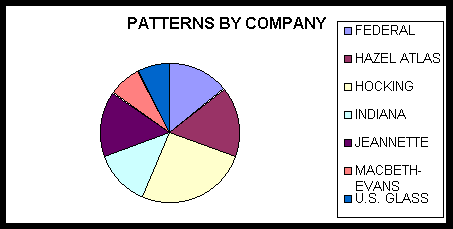
| Joyce was a featured Seminar Speaker at the 2004 NDGA Convention in Council Bluffs, Iowa |
INTRODUCTION
The information in this paper is based on 92 Depression Glass patterns made by the seven major producers of Depression Glass from 1923 to 1939. These seven producers are: Indiana Glass Company; Hocking Glass Company, Federal Glass Company, U.S. Glass Company, Jeannette Glass Company, MacBeth-Evans Glass Company and Hazel-Atlas Glass Company.
Most of today's Depression Glass reference books show the patterns in alphabetical order, from Adam to Windsor. This is very useful for learning to identify the patterns and for easy reference. In accordance with this tradition this paper starts with Adam and Windsor. From an historical perspective, although each of these patterns has importance, they do not represent the beginning and the end of the story. They do, however, show several important aspects of the depression glass era: the influence of art deco design on the glass industry; the extensive use of colored glassware; the use of mould etched designs; and the transition to a cut glass look at the end of the period.
Jeannette Glass made Adam for three years from 1932 through 1934. It was produced in five colors. Its importance is in its Art Deco shape—nearly every piece in this 37-piece set has either a square or conical aspect to its shape. These very Art Deco shapes are complimented by a classical mould-etched design. This pattern was made during the height of the Depression Glass era.
Windsor, also made by Jeannette Glass, was made for 11 years, from 1936 to 1946. It was produced in six colors and also was a 37-piece set. Windsor shows the movement toward a cut crystal look that developed near the end of the Depression Glass era. This look allowed this pattern to be successfully continued into the 1940's.
Depression Glass was a logical evolution in the production of glass—I like to call it "the industrial revolution comes to the glass industry." A large investment was needed for the machinery to make Depression Glass and it was fortunate that some companies had made this investment prior to 1929. This enabled them to continue both the production of glass and this revolution of the glass industry throughout the depression years.
In total, 19 companies made some Depression Glass. Twelve companies made from one to five patterns each, accounting for 24 patterns. The seven major Depression Glass producing companies made 92 different patterns. These companies probably made only Depression Glass during this era. Other companies made many types of glass including Depression, machine pressed and hand finished glass. Most companies did not quit making high quality glass during the Depression Glass era.
Thus, in the context of all glass making of the era, Depression Glass was but one part of the larger fabric of the glass industry. It was a logical extension of mechanization and a valuable contribution to a troubled economic era in that it kept people working. The end of the era also was logical in the context of economic stagnation and the changing consumer market. By the end of the 1930s, the techniques and machinery used for making Depression Glass were being abandoned for even more automated moulding methods. In addition, as the world moved into war, material shortages changed the nature and quantity of glass production.
Depression Glass is generally considered to be low quality glass, made by an automated moulding process with no polishing or hand finishing of rough edges. However, some of the patterns listed in the Depression glass reference books are of a somewhat better quality. Two examples are English Hobnail and Radiance.
Westmoreland Glass Company made English Hobnail from 1928 until 1983. Westmoreland's ware was handmade and hand-finished in a better quality glass than most Depression Glass. The colors made during the Depression Glass era are listed in reference books as Depression Glass even though it was not produced by the totally mechanized methods that generally define Depression Glass. It was made in eight colors during the depression era and there are 175 different pieces in this pattern.
New Martinsville Glass Company made Radiance from 1936 through 1939. This pattern is also listed in the Depression Glass books, but is clearly a higher quality glass than most Depression Glass in as much as it was able to be left without the designs that were generally used to cover up flaws in low quality glass.
As we can see from these examples, there is no absolute delineation of what is or is not Depression Glass. A general definition, expanded from Marian Klamkin's definition, is:
Useful glassware produced in a variety of colors during the period that roughly dates between 1920 and 1940. It was the first mass produced glassware, made by totally by machine, distributed nationally and sold cheaply. The glass was stylish, highly popular, pretty, and plentiful. It was poor quality glass made in interesting patterns and colors.
It is said that Depression Glass cannot be mistaken for glass made at any other time in American history. There was nothing like it before or after.
The patterns included in the charts and graphs in this paper are the 92 major patterns produced by the seven major companies producing Depression Glass during the fifteen year span of its production. In some cases data were not available for all 92 patterns. Although the first pattern, Avocado, was actually produced initially in 1923, I have included it in the first five-year period (1925-1929).
The reference books on Depression Glass tell which company made the pattern and provide information about the pieces and colors made in each pattern. Their organization does not, however, provide thorough insight regarding the chronology of the patterns, the companies making the glass, the approaches to design, the variety of colors, or the magnitude and length of production. Even though the content of these books includes this information, the alphabetical presentation makes it difficult to make comparisons among patterns and companies without further analysis.
These are the issues I have tried to deal with in this paper. The number of patterns from each of the seven major companies has been compiled. I have noted the years of production (based on the Gene Florence books unless other sources provide a specific year where Florence does not) counted the number of colors, number of pieces and number years of production for each pattern. This information is provided for all 92 patterns in the Depression Glass Pattern chart which is also referred to at the end of this article.
Patterns that represent the highlights of these characteristics have been selected for discussion in this paper as important to the history of Depression Glass. These patterns are presented in chronological order based on the year they were first introduced. The selection of patterns designated as important is entirely my own, based upon my research and judgement. In my research so far, I have rarely found references by other authors regarding the importance of a pattern.
Following the lead of the Cheryl Kevish articles "Adam to Windsor" in the Glass Collector's Digest, (see references) I have placed the patterns in groups of five years each based on the year in which each pattern was introduced. The periods used are 1925 through1929, 1930 through1934 and 1935 through 1939.
The following charts show the number of patterns introduced by each of the seven major companies for each five-year period, the total number of patterns produced by each company and the years each company was actively introducing new patterns.
| NUMBER OF PATTERNS BY COMPANY IN 5-YEAR PERIODS | ||||
|---|---|---|---|---|
| Company | 1925-29 | 1930-34 | 1935-39 | Total |
| Federal | 3 | 6 | 4 | 13 |
| Hazel-Atlas | 0 | 11 | 4 | 15 |
| Hocking | 4 | 9 | 11 | 24 |
| Indiana | 6 | 5 | 1 | 12 |
| Jeanette | 3 | 4 | 7 | 14 |
| MacBeth-Evans | 1 | 4 | 2 | 7 |
| U.S. Glass | 6 | 1 | 0 | 7 |

| Years in which new patterns | |
|---|---|
| were introduced by each Company | |
| Company Name | New Patterns Introduced |
| INDIANA Glass Company | 1923 TO 1933 |
| HOCKING Glass Company | 1927 TO 1939 |
| FEDERAL Glass Company | 1927 TO 1938 |
| U.S. GLASS Company | 1927 TO 1932 |
| JEANNETTE Glass Company | 1928 TO 1938 |
| MACBETH-EVANS Glass Company | 1929 TO LATE 1930'S |
| HAZEL-ATLAS Glass Company | 1930 TO 1938 |
THE FIRST FIVE YEARS, 1925-1929
The first five-year period, 1925 to 1930 is considered the experimental age of Depression Glass. Many patterns were conservative, but there was a great amount of Art Deco influence due to the impact of the 1925 International Exposition of Modern Decorative and Industrial Arts in Paris. Art Deco had an enormous design influence on glass, especially Depression Glass. Still, many of the early patterns were reworked patterns of the past.
This brings us to the first pattern that is considered Depression Glass, Avocado, introduced in 1923 by the Indiana Glass Company. It is important both because it was the first and because it was made for the longest number of years. It is an Art Nouveau pattern that was made for 11 years in four colors: green, pink, crystal and white milk glass. It is a luncheon and serving set comprised of 16 pieces. For the longest production run, Avocado is tied with Petalware made by MacBeth Evans and Windsor, made by Jeannette Glass.
The next three Depression Glass patterns were also introduced by the Indiana Glass Company but not until 1925 and 1926. These patterns are Indiana Sandwich (5 colors), Pyramid #610 (4 colors), and Tea Room (5 colors). Although the Sandwich pattern is a rework of one of the classical designs, the other two are dramatic Art Deco patterns. In Art Deco designed glassware, shape is the dominant attribute and you can clearly see this in these two patterns. The Pyramid pattern is an entertainment set with only 13 pieces. It has no plates, cups or saucers. The other two are large tableware sets with many pieces.
As I introduce each new company entering the Depression Glass market, I have selected one pattern from the year they entered the market to serve as the first pattern for that company. I do not have the information (although I'm sure it is available somewhere) that tells me which pattern was actually the first or whether a number of patterns were introduced at the same time in a given year. So the selection of patterns as examples is my own.
Three additional companies that next entered the Depression Glass business introduced the next three patterns in 1927. Hocking Glass introduced Ring, a 20-piece luncheon set made in two colors. U. S. Glass introduced Floral and Diamond Band, a 15-piece luncheon set in five colors; and Raindrops, another 20-piece luncheon set, was made in two colors and introduced by Federal Glass. Floral and Diamond Band marks the first pattern made in black glass. These are all conservative geometric patterns. Their significance is that they are among the first patterns offered by these companies.
Jeannette Glass was a pioneer in bringing together automation and color. In 1924 they were described as one of the most completely automatic factories in the country and by 1927 all hand operations had ended. Thus situated, Jeannette Glass was the fifth company to enter the Depression Glass market. Jeannette became noted for modern designs, their unique Ultra-marine color, cone shaped pieces and for including refrigerator and kitchen glassware in their sets.
In 1928 Jeannette Glass introduced Iris, an Art Nouveau pattern produced in three colors: crystal, pink and green. It was made for five years during the depression era, but was also produced in large quantities in crystal and iridescent from the 50's through the 70's. Iris is a 40-piece set with many styles of stemware and bowls as well as decorative pieces.
This same year, U.S. Glass introduced Aunt Polly, the first pattern made in blue glass. This is another Art Deco influenced design that combines a mixture of geometric aspects. It is a 21-piece luncheon set made in just three colors, green, blue and iridescent.
Block Optic by Hocking was introduced in 1929 and is significant for expanding the number of colors (6) and the number of pieces (56) as well as for having a variety of shapes for the same piece. For example, there are five styles of cups and saucers that include four shapes with five different handles. Also some plates have a center design and others have plain centers. As its name implies this is a geometric, optic design. With this pattern, Hocking began to establish its reputation as the largest producer of Depression Glass and the maker of the greatest variety of pieces.
Indiana Glass Company in 1929 added a very significant pattern to its line, Lorain #615, the first mould-etched design. Although the etch itself is a floral-basket design, the square shape of the pieces puts this pattern directly into the Art Deco category. It is a lovely blending of floral and Art Deco. The pattern used for both luncheon and dinner service, has 17 pieces and was produced in three colors: green, crystal and yellow. It was produced for only four years.
Cube was introduced by Jeannette Glass in 1929 and is significant for being made in the second largest number of colors (8): green, pink, crystal, amber, yellow, cobalt, teal and white. The Cube table setting has 23 pieces. This pattern is sometimes confused with Fostoria's American pattern because its optic design has a similar appearance to the American pattern. Cube was made for fiveyears.
The sixth company to enter the market, MacBeth-Evans, introduced Thistle in 1929. It was produced for only two years in four colors and has only seven pieces in the set. The pieces are: a luncheon plate; a grill plate, large bowl, small bowl, cup, saucer and cake plate. The design style is floral. MacBeth-Evans eventually became part of Corning Glass Works, but this is not the last time we will hear about MacBeth-Evans.
During the first five years of the Depression Glass era (1925 through 1929), 23 patterns were introduced by six different companies. The concepts of variety in color and sets with a large number of pieces had become established. During the first five years, the average length of production for a pattern was five years. Most patterns were made in either three or four colors, although by 1929 there was one pattern made in each of 6, 7 and 8 colors. By the late 20's companies were capable of producing enormous quantities of glass. Although moulds were costly to produce, one mould could produce many thousands of pieces. The Golden Age of Depression Glass was about to begin.
On the next page are two charts summarizing length of production and number of colors information for the Depression Glass patterns introduced during the first five-year period.
The first chart shows the number of patterns that were made for each number of years. For example: the first bar shows that two patterns were produced for two years; the second bar shows that one pattern was produced for three years. The final bar shows that one pattern introduced during this five-year period was produced for 11 years. Although other patterns were produced for 11 years, these others were introduced during subsequent 5-year periods.
The second chart shows the number of patterns that were made in various numbers of colors. For example: the first bar shows that one pattern was made in one color; the second bar shows that three patterns were made in two colors. From this chart you can see that most patterns introduced in this period were made in 3, 4 or 5 different colors.
Charts with similar information will be presented for each 5-year period.
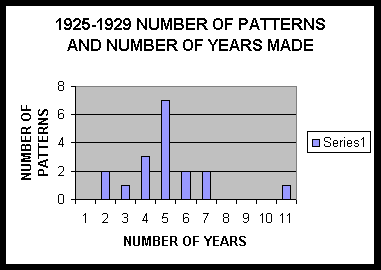 |
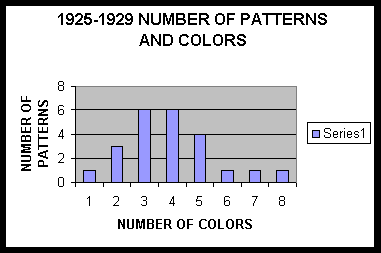 |
THE SECOND FIVE YEARS, 1930-1934 - THE GOLDEN AGE
The second five-year period, (1930 through 1934) was dominated by mould-etched designs, sets with numerous pieces and color, color, color. Forty different patterns were introduced by the seven main Depression Glass producing companies. The mould-etch innovation made a virtue out of the handicap of poor quality glass by providing pleasing, intricate designs. This is the same concept that had been used in early pattern glass production. There were numerous press-mould patterns as well. During this period the average length of production of a pattern was five years with seven patterns produced for five years and another seven produced for six years. Most patterns were made in 3, 4 or 5 colors during this period.
The seventh company, Hazel-Atlas, entered the market in 1930 with several patterns including Ovide, the first pattern on which decals and fired-on colors were used and New Century, which included the first amethyst color. Ovide was produced in three colors and is a 16-piece set. It was produced for six years. New Century was also produced for six years but in five colors. This set had 32 pieces. Both are geometric style patterns.
During this period, companies were moving to a consumer orientation and needed to produce enough patterns and colors to keep the consumer intrigued. All types of services were produced, from the full dinner service with accessory pieces to luncheon and card party settings. There was a piece for every occasion to match every décor.
For profitability, companies made boxcar-loads of one object in one color. Some items were sold by the carload only, especially at Jeannette Glass and Hocking. At Hocking, in one month 25 carloads of the same sets were sold. In three days one Chicago store sold 10,000 of Hocking's Cameo 19-piece water sets at $1 per set. Cameo is the only pattern to utilize a human figure as well as the pattern with the most pieces, 68. It was made in four colors: green, pink, crystal and yellow. Boxcars full of this pattern left Hocking every day. It was introduced in 1930 and was made for five years.
Cherry Blossom was introduced by Jeannette Glass in 1930 and was also sold by the boxcar-load. It has the distinction of being the first overall floral design as well as having a unique edge. It was made for ten years in seven colors and remains one of the most popular patterns for today's collectors even though there are many reproduced pieces that cause concern for collectors. There are 43 pieces in this pattern.
MacBeth-Evans introduced the next three important patterns in 1930. Dogwood is another overall floral etch. 1930 was apparently the year of the overall floral etch. Dogwood was produced for five years in six colors. There are 27 pieces in the set.
Petalware was mentioned earlier for its long production (11 years) and is also important for its china-like appearance, the use of fired on colors, especially on the edges and the use of decals. This very simple geometric design became a canvas for many treatments. Petalware was produced in six colors with many additional color variations available because of the edge treatments. There are 24 pieces in this dinner set.
American Sweetheart is significant for the use of the opaque Monax color through which an etched scroll design is barely visible. This pattern in the very elegant Monax color is probably the most well known MacBeth-Evans pattern. The Monax color with a blue edge combined with cobalt blue in the same pattern makes a wonderful showing for the table or decoration. American Sweetheart was made for seven years in six colors. The set has 33 pieces.
Mayfair is another Hocking pattern significant because it was produced in boxcar-load quantities. It was introduced in 1931 and produced in five colors for seven years. There are 63 pieces in this floral and geometric pattern. Princess is the third "boxcar-load" pattern from Hocking, also introduced in 1931. The pattern design is classic but the shapes have an Art Deco aspect. It was made for 5 years in four colors and is a 40-piece set. This was indeed the beginning of the big production era of Depression Glass.
Jeannette introduced Floral in 1931. An overall floral pattern, this is the pattern produced in the most number of colors, nine to be exact. The colors are: green, pink, crystal, yellow, amber, red, black, delphite, and jade-ite. These last two are Jeannette Glass opaque colors in light blue and light green. The pattern has a paneled optic and conical shapes lending it an Art Deco aspect. There are 49 pieces.
Sierra is another of the innovative Art Deco designs produced by Jeannette Glass. The angled edge of the plates is quite unique. It didn't become very popular because it chipped very quickly. The pattern was made for three years in three colors and has 15 pieces.
From Hazel-Atlas in 1932, we have the Florentine #1 and Florentine #2 patterns. These are significant because the same floral design was used on two differently shaped sets of dishes, a round/oval set and angular six–sided set. No. 1 (six-sided) was made for four years in five colors and has 35 pieces. No. 2 (round/oval) was made for five years and six colors and has 49 pieces.
Adam from Jeannette Glass, discussed at the beginning, was also introduced in 1932.
In 1933, Hocking introduced the well-known and popular with collectors, Miss America pattern, made in seven colors for five years. This pattern has 36 pieces and is a classical hobnail-type geometric design, quite different from many other patterns of this 5-year period.
Moderntone, introduced by Hazel-Atlas in 1934 was a return to Art Deco. With the use of sailboat decals, Moderntone became the Ships pattern. It was produced for nine years in five colors and has 28 pieces.
Royal Lace, introduced by Hazel-Atlas in 1934, has the distinction of being among the most expensive to collect today. This 28-piece pattern made for Sears Roebuck set a fancy and elegant table. It was made for eight years in five colors.
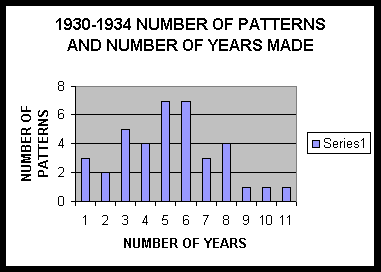 |
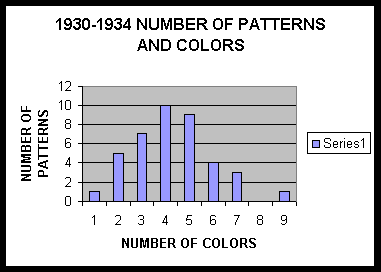 |
THE FINAL FIVE YEARS, 1935-39 – THE END OF AN ERA
By this time the mould-etch process of glass production had come to an end. There were no new mould-etched patterns introduced after 1934. From 1935
through 1939 there were 29 new patterns introduced, most before 1939. No new patterns were introduced in 1940. Sets now had fewer pieces and most new sets were luncheon or serving sets rather than sets for complete dinner service. The average number of years during which a pattern was produced declined to four. Six patterns were made for three years and seven patterns were made for five years. Six patterns were made in three colors and ten were made in four colors. Only one pattern, Windsor, was made in as many as six colors but nine were made in only one or two colors.
There was a return to a traditional look in design with more geometric and classical patterns. By the late 30's there was some customer resistance to clear glass dinnerware. Darker and opaque colors were introduced to cover the flaws in the glass. Opaque styles from MacBeth-Evans were attempts to make glass tableware that resembled china. Glass was losing its short-lived popularity as tableware.
In 1935, Federal Glass Works introduced Sharon, a unique off center, floral pattern made from a chip-mould process. Sharon was made for five years in four colors and includes 32 pieces in the set.
That same year Hocking introduced Old Colony, one of only two patterns with an open border. It was made for four years in only two colors. It has 36 pieces.
Hocking introduced Queen Mary in 1936 which, along with Windsor mentioned earlier from Jeannette Glass, is a geometric pattern that produces a brilliant effect similar to cut glass. Queen Mary was made for four years in three colors and has 38 pieces.
Royal Ruby when introduced was a color not a pattern. It was introduced by Hocking in 1938. Pieces from many of Hocking's patterns were made in this color which would be continued for many years to come. Oyster and Pearl, another pattern with only seven pieces, is an example of a pattern made in the Royal Ruby color. Over 56 pieces from various patterns were produced in this color. In later years a set was designed that became the Royal Ruby pattern.
Waterford was introduced by Hocking in 1938 and was made for seven years in four colors. This is another pattern that has some of the brilliance of cut crystal. It has an Art Deco aspect in its geometric design, and especially in its unique indented edge. The pattern includes 32 pieces.
MacBeth-Evans introduced Cremax and Chinex Classic in the late 30's to appeal to the growing taste for China dishes. The patterns were made in only th one base color, white and ivory respectively, but Cremax was made with colored rims and decals were applied to the Chinex Classic pattern. These were small patterns with 12 and 16 pieces respectively. Length of production is unknown.
With the introduction of Hocking's Sandwich pattern in 1939, the era of introducing new Depression Glass patterns came to an end. Hocking produced the Sandwich pattern off and on for the next 38 years. Only three colors (pink, royal ruby and crystal) were produced in 1939, but many new colors were introduced in later years. No new patterns were introduced after this, but in later years many would be revived and produced by the same or successor companies, or reproduced, often in new colors.
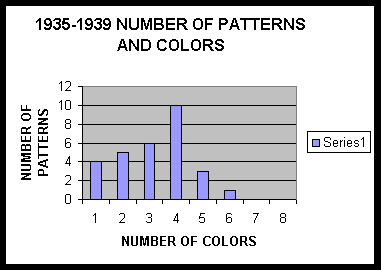 |
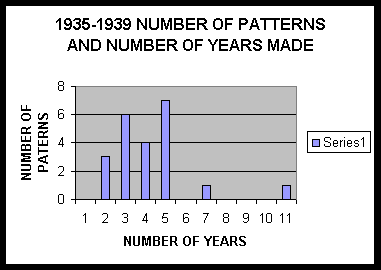 |
Bredehoft, Tom and Neila, Fifty Years of Collectible Glass 1920-1970, Antique Trader Books 1997, ISBN: 0-931625-79-X.
Florence, Gene, Collector's Encyclopedia of Depression Glass, Collector Books, 1998,.
Florence, Gene, Florence's Glassware Pattern Identification Guide, Collector Books, 1998.
Kevish, Cheryl, "Adam to Windsor," Parts 1 through 3, Glass Collector's Digest, Volume XI No. 3 Oct/Nov 1997 p. 73,
Ibid. Volume XI No. 4 Dec/Jan 1998 p. 18,
Ibid. Volume XI No. 6 Apr/May 1998 p. 14.
Klamkin, Marian, The Collector's Guide to Depression Glass, Hawthorn Books, Inc., 1973.
Mauzy, Barbara and Jim, Mauzy's Depression Glass, Schiffer Publishing Ltd., 1999, ISBN: 0-7643-0934-X.
Stout, Sandra McPhee, Depression Glass in Color, Wallace-Homestead Book Co., date obscured by Ramsey County Library label.
Stout, Sandra McPhee, Depression Glass Number Two, Wallace-Homestead Book Co., date obscured by Ramsey County Library label.
Weatherman, Hazel Marie, Colored Glassware of the Depression Era, Weatherman Glassbooks, 1976.
Weatherman, Hazel Marie, Colored Glassware of the Depression Era 2, Weatherman Glassbooks, 1974, ISBN: 0913074-04-7.
© 2002 Joyce E. Krupey - used by
permission
© 2003 National Depression Glass Association
For comments, suggestions or corrections to this site, contact Webmaster@NDGA.net
Last updated on December 3, 2004